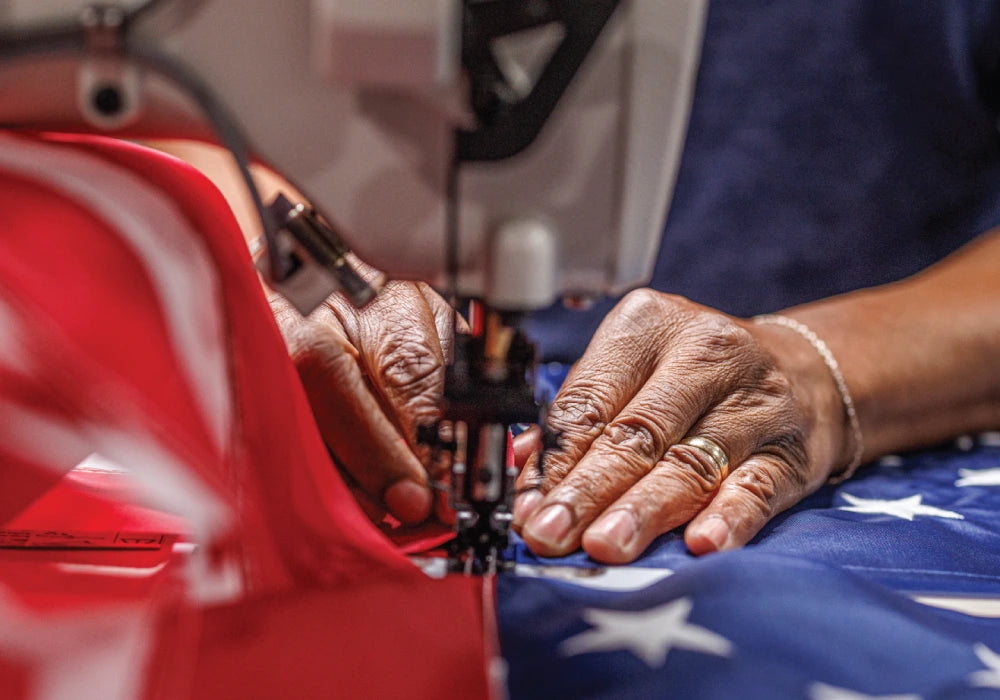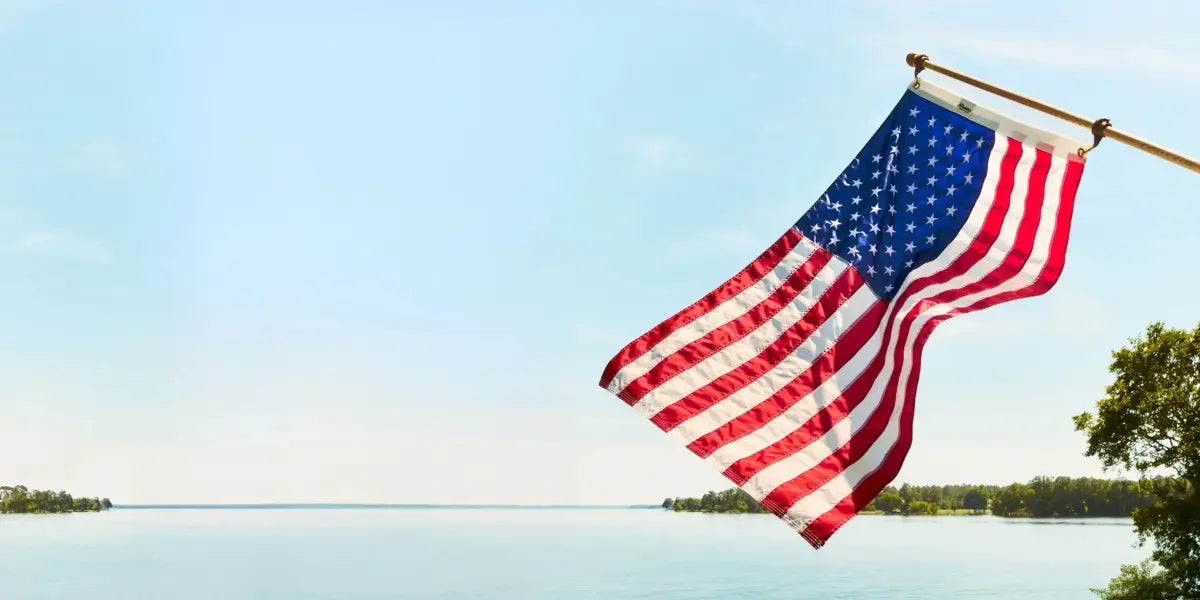Displaying the American flag is a time-honored way to show patriotism, but it comes with important etiquette and guidelines. Whether you’re getting ready for a national holiday or want a proud outdoor flag display at home, it’s crucial to follow proper protocols. This article provides practical flag display tips throughout the year. By understanding these rules and traditions, you can ensure your flag is shown the respect it deserves in every season.

Understanding American Flag Etiquette and the U.S. Flag Code
The Flag Code is a set of American flag rules and customs adopted in 1923 and later passed into law in 1942, detailing how the flag should be treated in civilian life. These rules for flying the American flag cover everything from how and when the flag can be displayed to how it should be handled and disposed of. The Flag Code makes clear that the flag is considered a living symbol of the nation and provides detailed guidelines for its display. By learning these guidelines, anyone can uphold the dignity of the flag. U.S. flag etiquette principles emphasize honor and respect. In general, the flag should be treated with care and respect. For example, one should never let it touch the ground or become tattered, and the flag should be displayed in a position of prominence wherever it flies.
When and How to Display the American Flag Outdoors
When planning an outdoor flag display, it’s important to observe the proper times and conditions for flying the flag. The U.S. Flag Code’s basic rule is that the flag should be displayed only from sunrise to sunset. You may fly the flag at night, provided it’s properly illuminated after dark. Additionally, you should consider weather conditions. The flag should not be flown during rain or snowstorms unless you have an all-weather flag made of durable, non-absorbent material. These guidelines are in place to prevent the flag from being damaged or displayed in a poor state. Tradition holds that the flag be displayed in fair weather by day, or around the clock if lit at night, and not left out during storms. Following these rules ensures the flag is always presented in its best form.
Beyond time of day and weather, consider the manner in which the flag is raised and lowered. The flag should be hoisted briskly in the morning and taken down ceremoniously in the evening. If you’re flying the flag on a fixed pole, raise it to the peak smartly and lower it gently. If displaying multiple flags on one pole, never hoist another flag above the U.S. flag. These basic rules for flying the American flag help maintain respect in any outdoor setting.
It’s also recommended to display the flag on certain significant days. While you can fly the flag on any day of the year, the Flag Code specifically encourages displaying it on national and state holidays and other patriotic occasions. Flying the flag frequently shows national pride. We’ll discuss seasonal and holiday displays in the next section, but always remember: whenever the flag is displayed, ensure it’s in good condition and displayed according to the code. With a little planning and care, your American flag setup will be both safe and respectful for outdoor use throughout the year.
Seasonal and Holiday Flag Display Traditions
Many Americans have traditions of displaying the flag during particular seasons and observances, and there are guidelines to follow for these occasions. Patriotic holidays in the summer months, for example, often inspire flag displays on homes and businesses. On Memorial Day in late spring, it’s customary to fly the flag at half-staff until noon and then raise it to full staff for the remainder of the day. This unique tradition honors fallen service members in the morning and raises the flag in their memory for the afternoon. In early summer, Flag Day (June 14) is specifically dedicated to celebrating the flag, and many people begin displaying their flags around this time if they haven’t already. The Fourth of July (Independence Day) is perhaps the most popular day for flying Old Glory – you’ll see flags lining residential streets and town squares as part of the celebration.
As autumn arrives, occasions like Patriot Day (September 11) and Veterans Day (November 11) call for prominent flag displays as well. Even in winter, there are notable days: for instance, the Flag Code lists Thanksgiving Day and Christmas Day as appropriate times to display the flag, emphasizing that patriotism isn’t limited to weather or season. If you choose to fly your flag in the winter months, ensure it’s an all-weather flag that can withstand rain or snow, and be mindful of daylight. With shorter days, proper illumination for nighttime display becomes even more important.
Some flying U.S. flag rules for seasonal etiquette include checking proclamations or local customs each year. The President or state Governor may order flags to be half-staffed on certain days or in remembrance of specific events. Staying aware of these orders is part of respectful flag display. Additionally, consider the condition of your flag through different seasons: high winds in spring or summer storms can fray a flag’s edges, and winter weather can soil or weaken the fabric. Rotate or replace your flag as needed so that a bright, intact flag is always flying. By observing the recommended holidays and seasonal guidelines, you uphold a sense of national unity and respect every time you raise the flag.

Displaying the Flag Correctly: Orientation and Placement
Knowing how to hang American flags properly is essential for a respectful presentation. “Orientation” refers to the direction and position of the flag, which must always honor the flag’s design. The blue field of stars (the Union) should always be positioned correctly, whether the flag is hung on a pole or displayed flat. Here are a few key scenarios for proper orientation and proper flag placement:
-
Wall or Window Display: If you hang the flag against a wall, either horizontally or vertically, the Union should be at the top and to the flag’s own right. An observer facing the flag should see the blue field at the top left. This rule ensures the flag is not displayed upside-down or reversed. When draping a flag on a wall behind a podium, place the stars on the upper left side from the audience’s perspective.
-
On a Staff from a Building: When the flag is flown from a staff projecting off a house, porch, or building, always attach it so that the Union is at the peak (the highest point of the staff). The only exception is if you are flying the flag at half-staff – in that case, first raise it to the peak briefly, then lower it halfway down the staff. But under normal display, the flag’s top (Union side) should be as high as possible on the pole. In practical terms, that means if you mount a flag on your home’s front porch with an angled bracket, make sure the blue stars field is at the tip of the pole closest to the house’s roof. A flag’s Union should never sag or hang down at the bottom when attached to a building; it belongs at the top of the staff.
-
Suspended Over a Street or Doorway: If you ever hang a flag over a street, the Union should face north if the street runs east-west, or face east if the street runs north-south. Similarly, if a flag is hung over a sidewalk from a building to a pole at the edge of the sidewalk, the Union should be away from the building, positioned toward the nearest street. These rules ensure the stars' field is in the proper position regardless of the vantage point.
-
Flagpoles and Height: When using an upright flagpole, ensure no other flag is flown above the U.S. flag on the same pole. The American flag can share a pole only beneath a church pennant during services at sea, but otherwise it must be at the top. Additionally, if you have multiple sections of a telescoping pole, extend it fully so the flag flies freely at the top. As a technical tip for American flag setup on a flagpole, the flag’s size should be proportionate to the pole’s height.
In all cases of mounting or hanging, ensure the flag can fall freely. It should not be fastened such that it bunches or is restricted by its attachments.
U.S. Flag Etiquette with Other Flags
When displaying the Stars and Stripes alongside other flags, additional protocols are in place to ensure the U.S. flag’s prominence. U.S. flag etiquette dictates that the flag is always in the position of honor when displayed with other flags. But what does that mean in practice? Here are the key rules for multiple-flag displays:
-
Multiple Flags on One Pole: If you are flying flags of different entities on the same flagpole, the U.S. flag must always be at the top. No other flag should ever be placed above the American flag on the same pole. The only narrow exception is during naval chapel services at sea, where a church pennant may briefly fly above the U.S. flag – an unlikely scenario for most civilians. In all regular circumstances, put the American flag up first, at the peak, then attach any subordinate flag(s) below it.
-
Flags on Separate Poles (U.S. Domestic Context): When flags are displayed in a group on separate flagpoles (for instance, the U.S. flag, a state flag, and perhaps a company or organizational flag), the American flag should be at the center of the group and at the highest point. Alternatively, if the poles are of equal height in a row, the U.S. flag should go on the right side of the flag. Essentially, if multiple flags are in a line, the U.S. flag should appear to the leftmost from the audience's perspective, which is the flag’s own right side. Other flags (state, city, organizational) should not be taller or larger than the national flag. By custom, the U.S. flag is raised first and lowered last in any group. No flag of a U.S. state or city, for example, should ever be placed to the right of or above the national flag.
-
Flags of Different Nations: International etiquette is slightly different in that no nation’s flag should be displayed higher than another's in times of peace. If you display the U.S. flag with flags of other countries, each country’s flag should be on a separate pole of the same height, and each flag should be roughly the same size. The U.S. flag would still go to its right (observer’s leftmost position) if the flags are in a row, but it would not be higher than the others. This equal footing is a sign of respect between sovereign nations. However, the American flag should never be subordinate; therefore, it should not be flown below another nation’s flag or in a lesser position.
When arranging any multi-flag display, remember that the American flag’s position of honor is paramount. By following this guidance, you show proper respect and avoid inadvertently slighting the U.S. flag among others.
American Flag Placement on Stage and Ceremonial Displays
If the flag is displayed flat, it ought to be above and behind the speaker’s position. You might see this in an auditorium where a large flag is draped on the back wall; it should be oriented so the Union (stars) is in the upper left from the audience’s view, and it should be placed higher than the speaker’s head. If the flag is instead on a staff on the stage, the correct placement is to the speaker’s right side. This means that as the speaker faces the crowd, the U.S. flag’s staff should be on their right-hand side. Any other flag, such as a state flag or organization banner, would then be placed on the opposite side. These stage placement rules ensure the flag isn’t inadvertently positioned as secondary. You’ll notice at political events or ceremonies that the American flag is either directly behind the speaker or on the speaker’s right-hand side on the stage.
Choosing a Quality Flag and American-Made Flag Manufacturers
Respect for the flag is also shown by the quality and origin of the flag you choose to display. All flags eventually wear out, especially those flown outdoors daily, but a well-made flag will last longer and retain its sharp appearance. Many American flag manufacturers produce flags in various fabrics and sizes, so you’ll want to select one that suits your climate and usage. For outdoor flags, durable nylon or polyester is usually recommended. Cotton flags have a traditional look but are best for short-term fair-weather display or indoor use, since they can mildew or fade faster outside. Whichever material you choose, inspect the workmanship: quality flags have strong stitching, embroidered or appliquéd stars, and vibrant, colorfast dyes.
American-made flags often adhere to higher standards of craftsmanship, and using one supports domestic industry, fitting, given that the flag represents the country. In fact, according to industry data, the vast majority of United States flags are still made domestically. About 94% of American flags are manufactured in the U.S., and only a small fraction are imported. Those imported flags, often sourced from overseas, may be of lower quality or contain inaccuracies.
Numerous companies proudly label their flags as “Made in the USA.” Look for flags certified by the Flag Manufacturers Association of America (FMAA), which guarantees that the product is truly 100% made in the United States. By choosing a flag from a reputable source, you also ensure it meets official proportion specifications. Many flag makers in the USA, such as Allegiance, specialize in high-quality American flags that are sourced and sewn domestically with care.

Displaying the American flag is both a privilege and a responsibility. By following the guidelines of flag etiquette – from timing and weather rules to proper flag placement and handling – you demonstrate honor for a revered national symbol. Seasonal awareness is key: know the special days when the flag should be flown, and adapt your display to the elements, using all-weather flags or taking the flag in during storms. Give the flag the best possible treatment: position it correctly, keep it clean and intact, and avoid any uses that could be seen as disrespectful. When the flag eventually shows its age, retire it honorably and replace it with a new one, ideally from a quality American manufacturer. Every courteous act, from briskly raising the flag at dawn to folding it at dusk, reinforces the values the flag stands for.
Sources
-
U.S. Department of Veterans Affairs – Guidelines for Display of the Flag (Public Law 94-344 Federal Flag Code summary)va.govva.gov
-
U.S. Department of Defense – Do’s and Don’ts for Displaying Old Glory (Flag etiquette tips, July 2019)defense.gov
-
Veterans of Foreign Wars – Flag Etiquette (VFW.org guidance on flag display rules)
-
Spectrum News – “American flags: The battle to keep them made in the USA” (news article by Corey James, Aug. 2024)spectrumlocalnews.com
-
National Flag Foundation – How to Display the Flag (flag etiquette guidelines, nationalflagfoundation.org)




